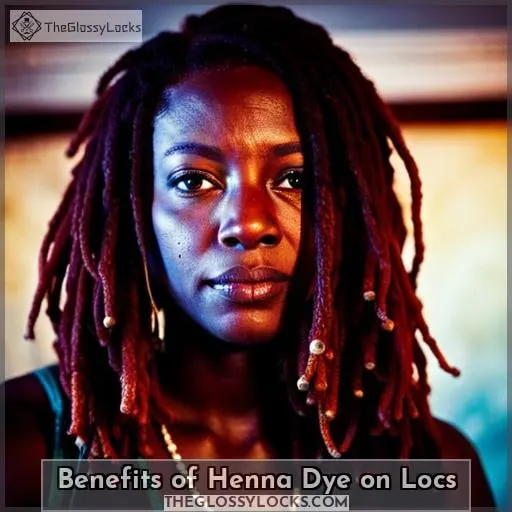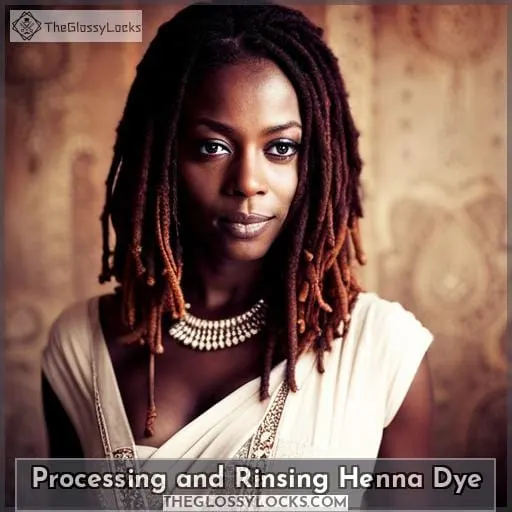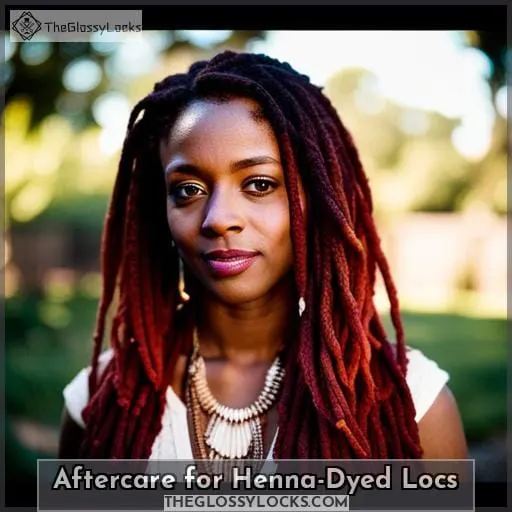This site is supported by our readers. We may earn a commission, at no cost to you, if you purchase through links.
 Want to add vibrant color to your locs without damaging them? Henna dye is a natural and chemical-free option that can give you the results you want.
Want to add vibrant color to your locs without damaging them? Henna dye is a natural and chemical-free option that can give you the results you want.
Step 1: Gather your supplies
- Henna powder
- Warm water
- Bowl
- Spoon
- Rubber gloves
- Plastic wrap
- Hair clips
- Old towel
Step 2: Prepare the henna dye
- In a bowl, combine 1 part henna powder with 2 parts warm water.
- Stir the mixture until it forms a thick paste.
- Cover the bowl with plastic wrap and let the mixture sit for at least 6 hours, or overnight.
Step 3: Apply the henna dye to your locs
- Put on the rubber gloves.
- Section your locs into small subsections.
- Apply the henna dye to each section of locs, using a spoon or your fingers.
- Cover your locs with plastic wrap and let the dye sit for 4-6 hours.
Step 4: Rinse out the henna dye
- After 4-6 hours, rinse the henna dye out of your locs with warm water.
- Shampoo and condition your locs as usual.
Step 5: Enjoy your new color!
Your locs will now be a vibrant new color. The color will gradually fade over time, but you can always reapply the henna dye to maintain the color.
Table Of Contents
Key Takeaways
- Gather all necessary supplies and prepare the hair and skin before applying henna dye.
- Mix the henna powder with the right liquids for a paste-like consistency and apply it evenly from roots to tips.
- Follow proper aftercare techniques to moisturize and seal the henna-dyed locks, use sulfate-free shampoos, and protect from sun exposure.
- Enjoy the natural, chemical-free benefits of henna dye, including hair strengthening and conditioning, vibrant color, and long-lasting results.
Benefits of Henna Dye on Locs
Henna dye is a natural and chemical-free option for coloring your dreadlocks. It can strengthen and condition your hair, and add vibrant color to your locs.
To learn how to use henna dye on your dreadlocks, read on!
Natural and Chemical-Free
While many hair dyes contain harsh chemicals, henna is a natural and chemical-free alternative that can be used to dye your locs.
Henna is a great choice for various reasons, including its suitability for dreadlocks and its ability to cover grey hair or add vibrant color to black or natural hair.
Unlike synthetic dyes, henna doesn’t contain harmful additives like PPD and ammonia.
Strengthens and Conditions Hair
To strengthen and condition your locs, henna dye provides natural benefits that nourish and enhance the health of your hair.
Henna prevents breakage, restores shine, nourishes the scalp, reduces frizz, and promotes growth. Its properties make it an ideal choice for maintaining healthy dreadlocks while adding vibrant color to your hair.
Incorporating henna into your hair care routine can help you achieve strong and luscious locs while avoiding harsh chemicals found in traditional dyes.
| Benefits of Henna Dye on Locs |
|---|
| – Prevents Breakage |
| – Restores Shine |
| – Nourishes Scalp |
| – Reduces Frizz |
| – Promotes Growth |
Adds Vibrant Color to Locs
Henna dye adds vibrant color to your dreadlocks without damaging them. It’s a safe and natural alternative to traditional hair dyes, with various henna dye brands offering a wide range of colors for you to choose from.
The application process involves mixing the henna powder with liquid and applying it evenly on your locs. With proper aftercare and maintenance, the vibrant color of henna can last for weeks on your beautiful locs.
Preparing Your Locs for Henna Dye
Before applying henna dye to your locs, it’s important to prepare them properly.
- Start by clarifying your hair with a clarifying shampoo to remove any product buildup or residue.
- Next, detangle and section your locs so that the dye can be evenly applied.
- Lastly, protect your skin and clothing by wearing gloves and using an old towel or shirt as a barrier.
Clarify Your Hair
Start by clarifying your hair before applying henna dye to your locs. This will remove any build-up of product and ensure that the dye takes evenly.
You can use a clarifying shampoo, apple cider vinegar, lemon juice, honey, or chamomile tea to clarify your hair. Avoid sulfates, as they can strip the hair of its natural oils and make it more difficult for the dye to take.
Detangle and Section Your Locs
Detangle your locs before applying henna dye to ensure even distribution of the color.
How to Detangle Locs
- Use a wide-toothed comb and work from the bottom up.
- Apply conditioner and leave it in for 30 minutes.
- Rinse thoroughly.
- Section your locs before applying henna dye.
Protect Your Skin and Clothing
Once you’ve detangled and sectioned your locs, it’s time to protect your skin and clothing.
- Wear gloves.
- Cover your scalp with plastic wrap.
- Protect your clothes with old towels.
Avoid contact with your skin, as henna and indigo can cause an allergic reaction.
- Patch test before using henna to ensure you don’t have a reaction.
Mixing and Applying Henna Dye
Now it’s time to mix and apply the henna dye to your locs.
Start by choosing the right henna powder for your desired color outcome.
Mix the henna with a liquid of your choice, such as lemon juice or tea, until you achieve a thick paste consistency.
Then, apply the henna paste generously from roots to tips, making sure all of your locs are covered evenly.
Choosing the Right Henna Powder
Now that you have clarified your hair and detangled your locs, it’s time to choose the right henna powder for dyeing.
- Organic. Make sure the henna powder is 100% pure and authentic.
- Vegan. Avoid henna powders that contain harsh chemicals or animal products.
- Affordable. Good quality henna powder can be expensive, but it’s worth it for the long-lasting, vibrant color.
Mixing Henna With Liquid
With the right henna powder chosen, you can mix it with a liquid to create a paste.
Lemon juice, tea, coffee, coconut milk, and apple cider vinegar are all commonly used liquids when preparing henna dye for locs. These liquids help activate the color pigments in the henna and enhance its effectiveness on your hair.
Mixing your chosen liquid with henna powder is an essential step in preparing to apply the dye onto your locs for vibrant results.
Applying Henna to Your Locs
To apply henna dye to your locs, start by mixing the henna powder with liquid.
You can use water or other acidic liquids like lemon juice or tea for a more gentle application.
Mix until you achieve a smooth paste-like consistency.
Once mixed, apply the henna paste from roots to tips, ensuring that every strand is coated evenly.
Use gloves and avoid getting the dye on your skin or clothing as it may stain temporarily.
Processing and Rinsing Henna Dye
Now that you have applied the henna dye to your locs, it’s important to allow it to process for the recommended amount of time.
Covering your hair with a plastic cap or wrapping it in cling film can help maintain heat and enhance color penetration.
Once the processing time is complete, thoroughly rinse out the henna using warm water until the water runs clear.
Allowing Henna to Process
After applying henna to your locs, you need to allow it to process for the desired amount of time.
Wrap your locs in plastic wrap and leave the henna on for 4-6 hours.
Avoid heat during processing and thoroughly rinse the henna out after rinsing.
Condition your locs to restore moisture.
Covering and Maintaining Heat
During the henna dyeing process, it’s important to cover your locs and maintain heat for optimal color development.
3 ways to cover your locs:
- Plastic wrap
- Plastic bag
- Shower cap
3 ways to maintain heat:
- Hot water bottle
- Aluminum foil
- Hair dryer
Thoroughly Rinsing Out Henna
Rinse the henna out of your locs thoroughly with warm water until the water runs clear. The rinsing process can take up to 4 hours, depending on the thickness of your locs.
Tips for Rinsing Henna
- Use warm water.
- Rinse thoroughly.
- Avoid harsh shampoos.
- Use a clarifying shampoo.
- Moisturize your hair.
Aftercare for Henna-Dyed Locs
Now that you’ve successfully dyed your locs with henna, it’s important to take proper care of them for long-lasting results.
Moisturizing and sealing your locs regularly will help maintain their health and prevent dryness.
Avoiding harsh shampoos and chemical-laden products is crucial in preserving the vibrant color of your henna-dyed locs.
By following these aftercare tips, you can ensure that your henna dye job stays beautiful and vibrant for as long as possible.
Moisturizing and Sealing Locs
To maintain the vibrant color and health of your henna-dyed locs, it’s important to moisturize and seal them regularly.
- Deep condition your locs once a week to keep them hydrated and nourished.
- Consider using a hot oil treatment with oils like argan or coconut oil for added moisture.
- After washing, apply a leave-in conditioner to lock in moisture, then seal with an oil like argan or coconut oil for extra protection.
Follow these tips for optimal aftercare of your henna-dyed locs.
Avoiding Harsh Shampoos and Chemicals
Once you’ve moisturized and sealed your locs, you’ll want to avoid harsh shampoos and chemicals to preserve the vibrant color.
- Use sulfate-free shampoos.
- Avoid hot water.
- Use gentle styling products.
- Avoid bleach and chemical dyes.
Maintaining Vibrant Color
After avoiding harsh shampoos and chemicals for 72 hours, you can begin to maintain the vibrant color of your henna-dyed locs by:
- Using cold water
- Avoiding sulfates
- Using color-safe products
- Reapplying henna regularly
- Protecting color from sun exposure
Tips and Tricks for Successful Henna Dyeing
Before you begin dyeing your dreadlocks with henna, it’s important to conduct a patch test to ensure that you don’t have an allergic reaction.
You can also experiment with mixing henna colors to create your desired shade, and if you need any help, don’t hesitate to seek professional advice.
Conducting a Patch Test
Before applying henna dye on your locs, it’s important to conduct a patch test to ensure compatibility and avoid any potential allergic reactions.
- Patch test location: Behind the ear or on a strand of hair.
- Patch test time: 24-48 hours.
- Patch test results: Any redness, swelling, or itching is a sign of an allergic reaction.
- Patch test aftercare: Wash the area with soap and water.
- Patch test success: If there are no signs of an allergic reaction, you can proceed with dyeing your locs.
Experimenting With Mixing Henna Colors
Once you’ve conducted a patch test and are happy with the results, you can experiment with mixing henna colors to create your own unique hue.
| Henna Color | Mixture | Result |
|---|---|---|
| Red henna | – | Red |
| Orange henna | Red henna + turmeric | Orange |
| Black henna | Indigo henna + red henna | Black |
| Highlights | Red henna + blonde highlights | Caramel highlights |
| Ombre | Red henna + black henna | Red to black ombre |
| Lowlights | Black henna + blonde lowlights | Black to blonde lowlights |
Seeking Professional Help if Needed
Sometimes, it’s helpful to seek professional help when dyeing your dreadlocks with henna.
Local henna artists can provide guidance and support, ensuring that you get the results you want.
Frequently Asked Questions (FAQs)
What are the differences between henna and indigo?
Henna is a natural dye that can only dye hair red-orange, while indigo can dye hair black.
To achieve a natural black color, henna is applied first, followed by indigo.
How long does henna last on dreadlocks?
Henna’s lasting power on your dreadlocks depends on factors like hair health and maintenance. With proper care, expect the effects to endure for approximately 6 weeks, granting you a vibrant and enduring transformation.
Can I use henna on my dreadlocks if I have sensitive skin?
Yes, you can use henna on your dreadlocks even if you have sensitive skin. Henna is a natural dye that’s generally well-tolerated, but it’s always recommended to do a patch test first to ensure no adverse reactions occur.
What are the best henna dyes for dreadlocks?
To achieve vibrant and healthy dreadlocks, consider using natural henna dyes.
These dyes, like It’s Pure Organics, offer a range of shades without harsh chemicals.
Embrace the power of self-expression with safe and lasting results for your locs.
How do I remove henna from my dreadlocks?
To remove henna from your dreadlocks, try using:
- A clarifying shampoo
- A mixture of baking soda and water
Gently massage the solution into your locs, rinse thoroughly, and repeat if necessary.
Conclusion
With henna dye, you can achieve:
- Vibrant, natural-looking color
- Color that will last for months
So what’re you waiting for?
Get started on your henna dye journey today!









